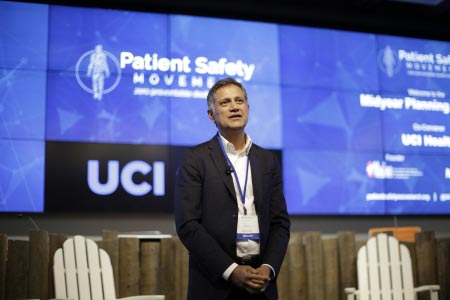The Patient Safety Movement’s 2018 Midyear Planning Meeting, co-convened by UCI Health, kicked off with a call to action for those in attendance. Namely, to implement processes to prevent medical errors, the third leading cause of death in the United States and fourteenth worldwide.
“We are a little over a year from 0X2020. While there are other challenges we need to address, we believe we have found the main causes of preventable harm where we need to focus. We are not changing our goal. ZERO by 2020 is still possible, but we need everyone’s help. To not put processes in place to eliminate preventable death is unconscionable,” said Joe Kiani, Chairman and Founder of the Patient Safety Movement Foundation.
The full-day working meeting brings together 100 leading medical experts, policymakers, technologists and patient advocates from eight countries for an in-depth examination and discussion of the six leading causes of preventable patient deaths in hospitals, including:
- Healthcare-associated Infections
- Medication Errors
- Early Detection and Treatment of Sepsis
- Hand-off Communications
- Failure to Rescue: Monitoring Opioid-Induced Respiratory Depression
- Venous Thromboembolism (VTE)
With just two years away from the Patient Safety Movement’s ambitious goal of ZERO preventable deaths by 2020, UCI Health, a multiple award-winning hospital, opened the day with a detailed look at how they became the first academic medical center to implement 30 evidence-based Actionable Patient Safety Solutions (APSS). Chief Medical Officer, Dr. William Wilson, detailed their inspiring plan to become a high-reliability organization and become recognized in the top ten percent for all hospital ranking systems.
“A patient who enters the hospital without an injurious condition, should never experience one or leave having received any harm. If they come in without a pressure injury, they should not leave with one. If they come in without an infection; they should not leave with one or become infected in the hospital. There’s no reason that we should not have 100% safe hospitals,” said Dr. Wilson.
SENATOR TODD YOUNG DISCUSSES THE NEED FOR ALIGNED INCENTIVES IN HEALTHCARE
Joining the meeting from Washington, D.C., the Honorable Todd Young, United States Senator for Indiana, led a discussion on the need for aligned incentives in healthcare.
“I want to thank the Patient Safety Movement Foundation for leading the charge to make our healthcare system a safer place for patients,” said U.S. Senator Todd Young (R-Ind.). “One preventable death is one too many, and our healthcare system should be doing more to make patient safety a priority. I look forward to introducing legislation that will ensure hospitals are using proven best practices to prevent unintended outcomes and reduce preventable deaths.”
EXPERTS EXPRESS A NEED TO TAKE ACTION TO PREVENT POSTOPERATIVE DELIRIUM AND A NEED FOR PATIENT SAFETY CURRICULUM IN SCHOOLS
The Midyear Planning Meeting also included presentations on delirium and the development of a patient safety curriculum for all healthcare professionals. Delirium is an emerging topic in patient safety. An estimated 2.6 million patients are affected by delirium in the United States alone and between 30 to 40% of delirium is estimated to be preventable. In a study on patient outcomes, it was found that delirium is associated with higher in-hospital mortality, shorter survival over the course of hospitalization, longer ICU and hospital stays, more frequent readmission to the ICU for the same hospitalization event and higher healthcare costs.1 The presentation on delirium was followed by a short discussion on how an actionable solution will be developed on this topic. Dr. Fleisher and Dr. Peden will convene a group of multi-disciplinary patient safety experts to develop an Actionable Patient Safety Solutions (APSS) which will be released at the upcoming 7th Annual World Patient Safety, Science & Technology Summit on January 18th, 2019.
“Delirium can affect everyone. More than 2.6 million people in the United States are affected by post-operative delirium which is tied to higher complication, mortality rates and the inability to return home. One-third of people undergoing surgery in the U.S. are over 65, and those patients are at greatest risk of developing delirium and post-operative cognitive changes,” said Dr. Lee Fleisher, Professor, and Chair of Anesthesiology and Critical Care, Perelman School of Medicine of the University of Pennsylvania.
“We are talking about is implementing simple steps that every single hospital can do. This needs to be a multi-pronged public health campaign involving all hospitals, providers, patients and their families since we now know up to 40% is preventable,” added Dr. Carol Peden, Professor of Anesthesiology, Keck School of Medicine, University of Southern California.
Similarly, Dr. Steven Scheinman, MD, President and Dean, Geisinger Commonwealth School of Medicine, updated the group on their progress to build a patient safety curriculum in healthcare, a practice that the World Health Organization has recommended since 2009. PSMF’s special curriculum workgroup is focused on developing a core curriculum which can be applied across all healthcare professional educational programs. The workgroup is focused on the need to embed patient safety within the curriculum, from year one, day one, of training. The curriculum workgroup developed and presented their work on 6 of 8 major domains. The curriculum is scheduled to be published in January 2019 at the World Patient Safety, Science and Technology Summit.
“We recognize that one of the most important elements in training is the role modeling that occurs in the work environment. The culture of safety for ZERO errors does not exist yet. We want to make ownership of the patient’s safety part of the professional identity of all caregivers. The goal of all this is to build a culture of safety and empower the learners to be change agents in the workforce,” explained Dr. Scheinman.
The Midyear Planning Meeting concluded with breakout sessions on the six leading causes of preventable patient deaths in hospitals. For more information, please visit the Patient Safety Movement Foundation : http://patientsafetymovement.org/



